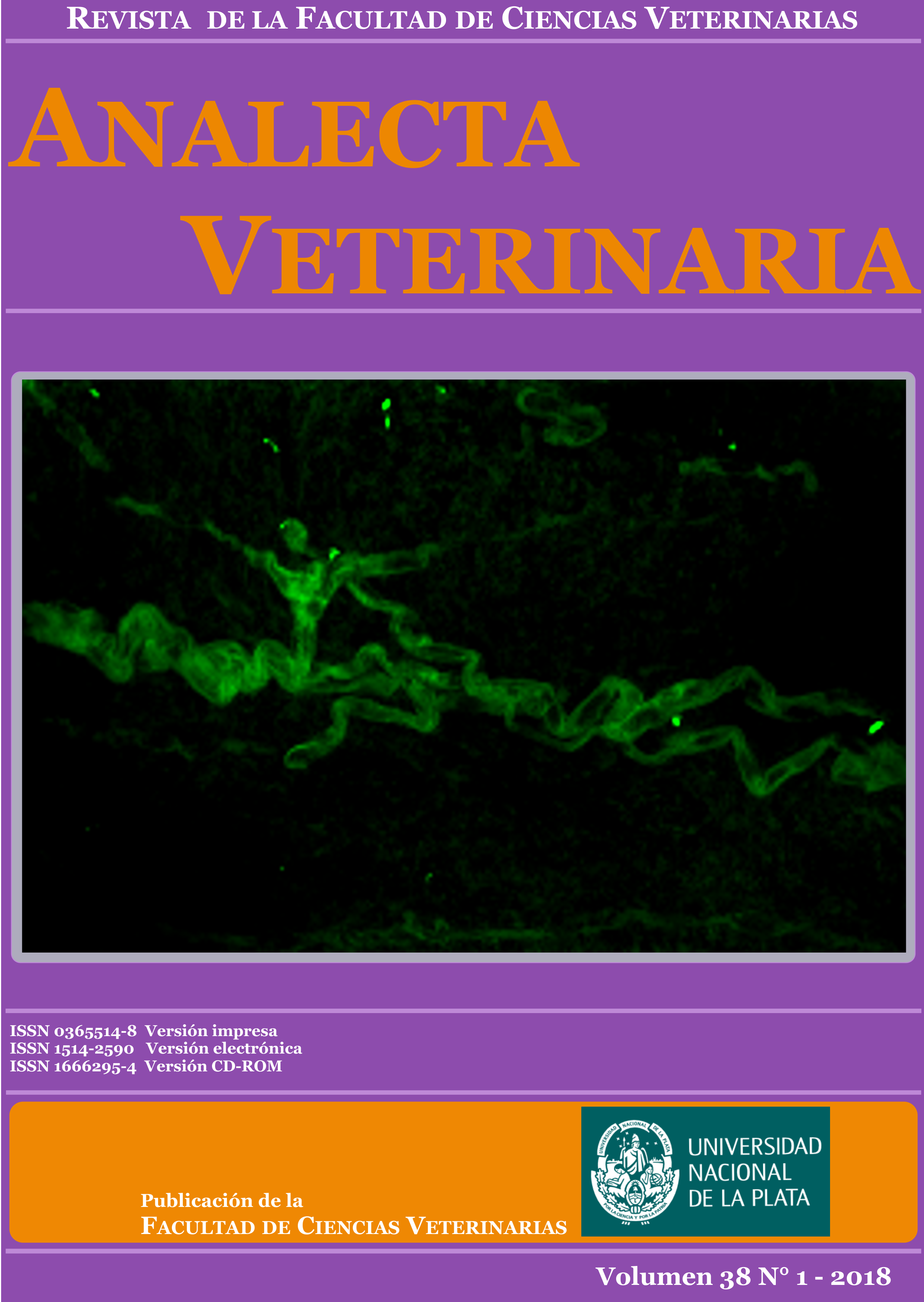Detection by pyrosequencing and prevalence of canine ABCB1 gene mutation nt230 [del4] in sheep dog breeds of Buenos Aires province
DOI:
https://doi.org/10.24215/15142590e019Keywords:
Dogs, P-glycoprotein, neurotoxicity, pyrosequencing, prevalenceAbstract
ABCB1 gene codes for P-glycoprotein (Pgp), a membrane protein that transports multiple drugs out of the cell. It is mainly expressed in the bloodbrain barrier, although it also plays a role in other organs. In dogs, a 4 bp deletion in exon 4 of ABCB1 gene has been reported. This mutation results in a premature stop codon and a nonfunctional protein. Homozygous animals for the deletion present neurotoxicity when administered drugs such as avermectins. This mutation is found mainly in collie, border collie and other related dog breeds. The aim of the present work was to develop a pyrosequencing method for rapid diagnosis of the ABCB1 gene nt230 [del4] mutation and validate it by direct sequencing in a local population. A total of 72 dogs were analyzed, obtaining a 100 % agreement between both methods. The genetic variation of the mutated allele (q) showed differences between the evaluated breeds: collie (n = 30; q = 0.32), border collie (n = 17; q = 0.06), Shetland sheep dog (n=12; q= 0), others (n=13; q = 0). On average, the q value was lower than reported in other countries. Pyrosequencing could be used for early diagnosis of Pgp deficiency, being a very useful tool for controlled reproduction in kennels and for the prevention of neurotoxicity in patients treated with avermectins and other Pgp substrate drugs.
Downloads
Metrics
References
Calboli FC, Sampson J, Fretwell N, Balding DJ.2008. Population structure and inbreeding from pedigree analysis of purebred dogs. Genetics. 179(1):593601. doi: 10.1534/genetics.107.084954
Fromm MF. 2003. Importance of Pglycoprotein for drug disposition in humans. European Journal of Clinical Investigation. 33(2):69.
Gramer I, Leidolf R, Döring B, Klintzsch S, Krämer EM, Yalcin E, Petzinger E, Geyer J. 2011. Breed distribution of the nt230(del4) MDR1 mutation in dogs. The Veterinary Journal. 189(1):6771. doi: 10.1016/j.tvjl.2010.06.012
Geyer J, Döring B, Godoy JR, Leidolf R, Moritz A, Petzinger E. 2005. Frequency of the nt230 (del4) MDR1 mutation in Collies and related dog breeds in Germany. Journal of Veterinary Pharmacology and Therapeutics. 28:54551. doi: 10.1111/j.13652885.2005.00692.x
Huebner J, Kühnlein P, LangbeinDetsch I, Müller E. 2007. LABOKLIN. Canine MDR1 mutation breed disposition and prevalence in dogs in Germany. [ONLINE] Disponible en: http://v17.laboklin.com/. Consultado 10/10/2017.
Hugnet C, Bentjen SA, Mealey KL. 2004. Frequency of the mutant MDR1 allele associated with multidrug sensitivity in a sample of collies from France. Journal of Veterinary Pharmacology and Therapeutics. 27:227 9. doi: 10.1111/j.13652885.2004.00585.x
Firdova Z, Turnova E, Bielikova M, Turna J, Dudas A. 2016. The prevalence of ABCB1:C. 227_230delATAG mutation in affected dog breeds from European countries. Research in Veterinary Science. 106:8992. doi: 10.1016/j.rvsc.2016.03.016
Kawabata A, Momoi Y, InoueMurayama M, Iwasaki T. 2005. Canine mdr1 gene mutation in Japan. Journal of Veterinary Medical Science. 67:110307. doi: 10.1292/jvms.67.1103
Löscher W, Potschka H. 2005. Role of drug efflux transporters in the brain for drug disposition and treatment of brain diseases. Progress in Neurobiology. 76:2276. doi: 10.1016/j.pneurobio.2005.04.006
Mealey KL, Bentjen SA, Gay JM, Cantor GH. 2001. Ivermectin sensitivity in Collies is associated with a deletion mutation of the mdr1 gene. Pharmacogenetics. 11:72733. doi: 10.1097/0000857120011100000012
Mealey KL, Munyard KA, Bentjen SA. 2005. Frequency of the mutant mdr1 allele associated with multidrug sensitivity in a sample of herding breed dogs living in Australia. Veterinary Parasitology. 131:1936. doi: 10.1016/j.vetpar.2005.05.004
Neff MW, Robertson KR, Wong AK, Safra N, Broman KW, Slatkin M, Mealey KL, Pedersen NC. 2004. Breed distribution and history of canine mdr11, a pharmacogenetic mutation that marks the emergence of breeds from the collie lineage. Proceedings of the National Academy of Science of the United States of America. 101(32):1172530. doi: 10.1073/pnas.0402374101
Nelson OL, Carsten E, Bentjen SA, Mealey KL. 2003. Ivermectin toxicity in an Australian Shepherd dog with the MDR1 mutation associated with ivermectin sensitivity in Collies. Journal of Veterinary Internal Medicine. 17:3546. doi:10.1111/j.19391676.2003.tb02461.x
Roulet A, Puel O, Gesta S, Lepage JF, Drag M, Soll M, Alvinerie M, Pineau T. 2003. MDR1deficient genotype in Collie dogs hypersensitive to the Pglycoprotein substrate ivermectin. European Journal of Pharmacology. 460:8591. doi: 10.1016/S00142999(02)029552
Schinkel AH. 1999. Pglycoprotein, a gatekeeper in the bloodbrain barrier. Advanced Drug Delivery Reviews. 36:17994. doi: 10.1016/S0169409X(98)000854
Stiedl C, Weber K. 2017. Fast and simple detection methods for the 4–base pair deletion of canine MDR1/ABCB1 gene by PCR and isothermal amplification. Journal of Veterinary Diagnostic Investigation. 29(2):17680. doi: 10.1177/1040638716683213
Downloads
Published
How to Cite
Issue
Section
License
Authors retain the copyright and assign to the journal the right of the first publication, with the with the terms of the Creative Commons attribution license. This type of license allows other people to download the work and share it, as long as credit is granted for the authorship, but does not allow them to be changed in any way or used them commercially.

Analecta Veterinaria by School of Veterinary Sciences, National University of La Plata is distributed under a Creative Commons Attribution-NonCommercial-NoDeriv 4.0 International License.

























